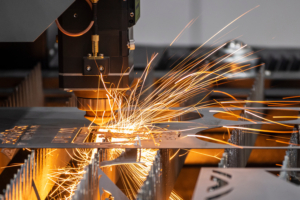What Is Custom Metal Fabrication?
Custom metal fabrication is a sophisticated process that combines raw metal materials to create specialized designs and products. Unlike mass production, which relies on standardized components, custom fabrication emphasizes flexibility and design uniqueness tailored to specific requirements. This approach supports various industries, from construction and automotive to aerospace and art installations.
Custom fabrication merges art with engineering, transforming basic metal sheets and bars into intricate and purposeful components. For example, in sectors like architecture, fabricators often work on bespoke projects that require a balance of aesthetics and functionality. By leveraging their expertise in metal fabrication, skilled artisans can meet demanding project specifications and challenges, whether tasked with creating delicate ornamental pieces or robust structural elements.
Key Materials and Techniques
Choosing the suitable materials and techniques is vital to the success of any metal fabrication project. The selection process often begins with understanding the desired outcome and characteristics of the final product. Common materials include:
- Structural steel, which offers durability and strength.
- Aluminum is renowned for being corrosion-resistant and lightweight.
- Stainless steel is prized for its aesthetic appeal and high resistance to rust and staining.
Equally crucial is the mastery of various fabrication techniques. For instance, cutting methods might employ precision tools such as laser cutters or plasma torches, depending on the required accuracy and material thickness. On the other hand, welding fuses metal components and can involve different procedures like MIG or TIG welding, each suitable for specific materials and conditions. Additional processes such as bending and assembling ensure the final structure is coherent and stable, meeting clients’ functional and aesthetic standards.
The Importance of Precision in Fabrication
Precision in metal fabrication is more than a desirable attribute; it is necessary. The precision with which metal parts are modeled, cut, and assembled can distinguish between project success and failure. For instance, even minor deviations from specified dimensions can lead to serious safety hazards or operational inefficiencies when dealing with structural components.
To achieve the high accuracy required, fabricators often rely on advanced machinery such as CNC (Computer Numerical Control) systems, which provide controlled precision. These systems translate computer-generated designs into physical products with minimal error, ensuring that parts fit together perfectly, operate as intended, and meet all safety regulations. Investing in precision not only guarantees project integrity but also saves time and resources by reducing the need for rework.
Technological Advancements in the Industry
The metal fabrication industry constantly evolves, with technology playing a crucial role in its transformation. The industry has changed thanks to innovations like 3D printing and laser cutting, which enable more intricate designs and faster manufacturing periods. Laser technology, in particular, allows fabricators to execute intricate cuts with high precision, optimizing material use and minimizing waste.
Another game-changing development is additive manufacturing, commonly known as 3D printing. By creating intricate components layer by layer, this technology makes it feasible to experiment with ideas that would be difficult or impossible to do with more traditional methods. According to IndustryWeek, the rise of intelligent factories integrates these advancements, enhancing efficiency and adaptability in manufacturing processes.
Sustainability Considerations
As environmental consciousness rises, sustainability remains critical in modern metal fabrication. The industry aims to use procedures that improve resource efficiency while lessening its adverse environmental effects. Recycling scrap metal, for example, is an essential strategy fabricators employ to minimize waste and lower production costs.
Energy-efficient practices, such as using renewable energies and optimizing machinery use, support sustainable goals by reducing carbon footprint. This sustainability movement is fueled by regulatory forces, which also mirror rising consumer demand for eco-friendly goods. As Forbes reported, embracing sustainable approaches can open new economic opportunities while contributing positively to the planet.
Choosing a Custom Fabricator
Selecting the appropriate fabricator is a critical decision that can impact the success of a custom metal project. Prospective clients should consider a fabricator’s experience, technical capabilities, and past project performance. A fabricator with a varied portfolio demonstrates versatility and the capacity to adjust to different project requirements.
Moreover, quality assurance and customer service are paramount. Fabricators should offer transparency throughout the manufacturing process and accommodate specific client requirements. Clients can establish a partnership that fosters creativity, problem-solving, and high-quality results by fully understanding the fabricator’s expertise and approach.
The Future of Metal Fabrication
The future of metal fabrication is poised for groundbreaking changes that promise to enhance production efficiency and creativity. AI and machine learning developments are predicted to drive this trend, providing predictive analytics to improve decision-making and optimize maintenance schedules.
Thanks to these technology linkages, fabricators will be able to anticipate problems, reduce downtime, and enhance the overall caliber of their work. Meanwhile, the continued exploration of new materials and techniques will enable custom fabrication to achieve unprecedented levels of innovation, shaping an industry that is dynamic, resilient, and ever-evolving.






